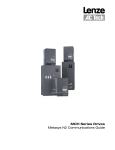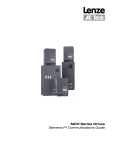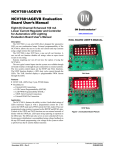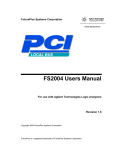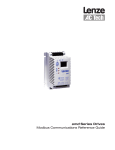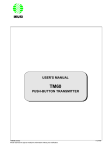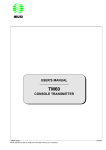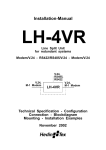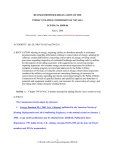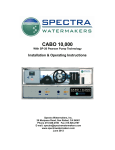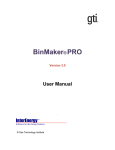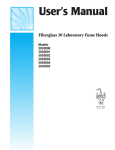Download BACnet Objects
Transcript
MCH Series Drives BACnet Communications Guide About These Instructions This documentation applies to the use of an MCH Series Variable Frequency Drive with BACnet protocol and should be used in conjunction with the MCH Series Installation and Operation Manual (Document MH01) that shipped with the drive. These documents should be read in their entirety as they contain important technical data and describe the installation and operation of the drive. ASHRAE and BACnet® are registered trademarks of the American Society of Heating, Refrigerating and AirConditioning Engineers, Inc., 1791 Tullie Circle NE, Atlanta, GA 30329, http://www.bacnet.org. Modbus ™ is a registered trademark of Schneider Electric, founder of Modbus-IDA, http://www.modbus-IDA.org. © 2003 AC Technology Corporation No part of this documentation may be copied or made available to third parties without the explicit written approval of AC Technology Corporation. All information given in this documentation has been carefully selected and tested for compliance with the hardware and software described. Nevertheless, discrepancies cannot be ruled out. AC Tech does not accept any responsibility nor liability for damages that may occur. Any necessary corrections will be implemented in subsequent editions. Contents 1 Safety Information..............................................................................................................1 1.1 Warnings, Cautions and Notes...............................................................................1 1.1.1 General.....................................................................................................1 1.1.2 Application................................................................................................1 1.1.3 Installation................................................................................................1 1.1.4 Electrical Connection.................................................................................2 1.1.5 Operation..................................................................................................2 2 Introduction........................................................................................................................3 2.1 MS/TP Communications.........................................................................................3 2.2 MS/TP Physical Layer............................................................................................3 2.3 Serial Communications Wiring...............................................................................3 3 Drive Setup and Programming............................................................................................4 3.1 Added Programming Parameters...........................................................................4 3.2 Omitted Parameters and Selections.......................................................................4 3.3 Modified Parameters and Selections......................................................................5 3.4 Serial Communication Setup..................................................................................5 4 MCH BACnet® Objects.......................................................................................................8 4.1 BACnet® Object Map............................................................................................8 4.2 Analog Input (AI) Object Descriptions.....................................................................9 4.3 Analog Value (AV) Object Descriptions....................................................................9 4.4 Binary Input (BI) Object Descriptions......................................................................10 4.5 Binary Output (BO) Object Descriptions..................................................................10 4.6 Binary Value (BV) Object Descriptions....................................................................10 4.7 Multi-State Input (MSI) Object Descriptions............................................................11 4.8 Multi-State Value (MSV) Object Descriptions..........................................................13 4.9 Reference and Links..............................................................................................13 i RG-MHBAC Safety Information 1 Safety Information 1.1 Warnings, Cautions and Notes 1.1.1 General Some parts of Lenze controllers (frequency inverters, servo inverters, DC controllers) can be live, moving and rotating. Some surfaces can be hot. Non-authorized removal of the required cover, inappropriate use, and incorrect installation or operation creates the risk of severe injury to personnel or damage to equipment. All operations concerning transport, installation, and commissioning as well as maintenance must be carried out by qualified, skilled personnel (IEC 364 and CENELEC HD 384 or DIN VDE 0100 and IEC report 664 or DIN VDE0110 and national regulations for the prevention of accidents must be observed). According to this basic safety information, qualified skilled personnel are persons who are familiar with the installation, assembly, commissioning, and operation of the product and who have the qualifications necessary for their occupation. 1.1.2 Application Drive controllers are components designed for installation in electrical systems or machinery. They are not to be used as appliances. They are intended exclusively for professional and commercial purposes according to EN 61000-3-2. The documentation includes information on compliance with EN 61000-3-2. When installing the drive controllers in machines, commissioning (i.e. the starting of operation as directed) is prohibited until it is proven that the machine complies with the regulations of the EC Directive 98/37/EC (Machinery Directive); EN 60204 must be observed. Commissioning (i.e. starting drive as directed) is only allowed when there is compliance to the EMC Directive (89/336/EEC). The drive controllers meet the requirements of the Low Voltage Directive 73/23/EEC. The harmonised standards of the series EN 50178/DIN VDE 0160 apply to the controllers. The availability of controllers is restricted according to EN 61800-3. These products can cause radio interference in residential areas. In the case of radio interference, special measures may be necessary for drive controllers. 1.1.3 Installation Ensure proper handling and avoid excessive mechanical stress. Do not bend any components and do not change any insulation distances during transport or handling. Do not touch any electronic components and contacts. Controllers contain electrostatically sensitive components, which can easily be damaged by inappropriate handling. Do not damage or destroy any electrical components since this might endanger your health! When installing the drive ensure optimal airflow by observing all clearance distances in the drive's user manual. Do not expose the drive to excessive: vibration, temperature, humidity, sunlight, dust, pollutants, corrosive chemicals or other hazardous environments. 1 RG-MHBAC Safety Information 1.1.4 Electrical Connection When working on live drive controllers, applicable national regulations for the prevention of accidents (e.g. VBG 4) must be observed. The electrical installation must be carried out in accordance with the appropriate regulations (e.g. cable cross-sections, fuses, PE connection). Additional information can be obtained from the regulatory documentation. The regulatory documentation contains information about installation in compliance with EMC (shielding, grounding, filters and cables). These notes must also be observed for CE-marked controllers. The manufacturer of the system or machine is responsible for compliance with the required limit values demanded by EMC legislation. 1.1.5 Operation Systems including controllers must be equipped with additional monitoring and protection devices according to the corresponding standards (e.g. technical equipment, regulations for prevention of accidents, etc.). You are allowed to adapt the controller to your application as described in the documentation. DANGER! • After the controller has been disconnected from the supply voltage, do not touch the live components and power connection until the capacitors have discharged. Please observe the corresponding notes on the controller. • Do not continuously cycle input power to the controller more than once every three minutes. • Close all protective covers and doors during operation. WARNING! Network control permits automatic starting and stopping of the inverter drive. The system design must incorporate adequate protection to prevent personnel from accessing moving equipment while power is applied to the drive system. Table 1: Pictographs used in these instructions Pictograph RG-MHBAC Signal word Meaning Consequences if ignored DANGER! Warning of Hazardous Electrical Voltage. Reference to an imminent danger that may result in death or serious personal injury if the corresponding measures are not taken. WARNING! Impending or possible danger for persons Death or injury STOP! Possible damage to equipment Damage to drive system or its surroundings NOTE Useful tip: If observed, it will make using the drive easier 2 Introduction 2 Introduction This document will explain how to operate an MCH Drive using BACnet protocol on a Master-Slave/TokenPassing (MS/TP) LAN. It is intended as a serial communications supplement only and will not discuss normal drive operations. For more information regarding normal drive setup and functionality, refer to the MCH Installation and Operation Manual (MH01). Some of the information contained in this document was provided by the ANSI/ASHRAE 135-2001 standard. Refer to http://www.bacnet.org for more information. 2.1 MS/TP Communications MS/TP communication is maintained by a Master & Slave relationship between the devices on the LAN. All communication is initiated by Master devices. The token passes network mastership from one Master device to another. Slave devices never initiate a service request. They only respond to service requests from master devices. The Native BACnet implementation in MCH Drives is for an MS/TP Slave device. Therefore, only devices that support static device binding will be able to communicate with an MCH drive. For an MS/TP EIA-485 network use shielded, twisted-pair cable with a characteristic impedance between 100 and 130 ohms. Maximum recommended length of an MS/TP segment is 1200 meters (4000 feet) with AWG 18 cable. Maximum number of nodes (unit loads) per segment is 32 (as specified by the EIA485 standard). Because MS/TP uses non-return to zero (NRZ) encoding, the polarity of the connection to the cable is important. The non-inverting input of the EIA-485 transceiver is designated as “+” and the inverting input as “-”. Connect a termination resistance of 120 ohms (± 5%) at each of the two ends of the segment medium. Ground the shield at one end only to prevent ground currents from being created. Each MCH drive is equipped with 100k ohm local bias resistors. 2.2 MS/TP Physical Layer Communication is half duplex. Bytes are transmitted using NRZ encoding with 1 start bit, 8 data bits, no parity and 1 stop bit. All bytes are transmitted with the least significant bit first. Communication is asynchronous with no more than 20 bit times of idle time between any two bytes of a frame. The communication baud rate for MCH Series Drives is 9600 bps. The bit sequence is as follows: DATA START 2.3 1 2 3 4 5 6 7 8 STOP Serial Communications Wiring Figure 1 illustrates the MCH Series Terminal Strip and connections for an MS/TP LAN. 1 2 5A 5B 6 10A 10B 2 12A 13A 13B 13C 13D 14 15 2 RXA TXB 16 17 18 EIA-485 + EIA-485 - Earth Ground Figure 1: MCH Terminal Strip Connect EIA-485+ terminal to MCH terminal TXB Connect MCH terminal 2 to Earth Ground. 3 Connect EIA-485- terminal to MCH terminal RXA RG-MHBAC Drive Setup & Programming 3 Drive Setup and Programming Most drive parameters (including those required for serial communications) are not accessible through the LAN. They can only be accessed by entering the Programming Mode of the drive itself. Refer to the MCH Installation and Operation Manual (MH01) for more information. The parameter information in manual MH01 is based on the standard MCH Series Modbus™ Drive. The differences between the drive programming parameters described in the manual and those that exist in the MCH Series BACnet® Drive are explained in sections 3.1-3.3 herein. 3.1 Added Programming Parameters 60 SERIAL TIMEOUT This parameter makes the serial watchdog timeout period selectable. (Section 3.4) 85 DEVICE NUM EX This parameter is used to extend the device number to its full 22-bit range of 0 to 4194303. If the device number of the drive exceeds a value of 65535, this parameter should be set to the value of bits 16-22 of the device number. Otherwise this parameter should be set to 0. 86 DEVICE NUMBER This parameter holds the value of bits 0-15 of the drive’s 22-bit device number. It can be used by itself to represent a device number in the range of 0 to 65535. If the device number exceeds 65535, then DEVICE NUM EX must also be used. Example: The device number is 124 (00007Ch). The value of bits 16-22 (DEVICE NUM EX) is 00h or 0. The value of bits 0-15 (DEVICE NUMBER) is 007Ch or 124. Example: The device number is set to its default value of 1240000 (12EBC0h). The value of bits 16-22 (DEVICE NUM EX) is 12h or 18. The value of bits 0-15 (DEVICE NUMBER) is EBC0h or 60352. NOTE The values of the DEVICE NUMBER and DEVICE NUM EX parameters are also appended to the object name of the drive to ensure that it is unique network-wide. Example: 3.2 If the device number of the drive is set to its default value of 1240000 (12EBC0h), the resulting object name for the device will be ‘AC Tech VFD 18-60352’. Omitted Parameters and Selections 36 SLEEP THRESHOLD Sleep Mode functionality has not been added to the MCH Series BACnet® drive so these drive parameters do not exist. 37 SLEEP DELAY 38 SLEEP BANDWIDTH 41 ANALOG INPUT FILTER 52 TB14 OUT 53 TB15 OUT 54 RELAY RG-MHBAC The following options have not been added to these parameters in the MCH Series BACnet® drive: INV MIN/MAX A MIN ALARM INV MIN ALARM MAX ALARM INV MAX ALARM 4 Drive Setup & Programming 3.3 3.4 Modified Parameters and Selections 24 AUTO SOURCE The default selection for this parameter has been changed to KEYPAD. Refer to Section 3.4 Serial Communications Setup for more information. 32 HZ MULTIPLIER The default setting for this parameter has been changed to 30.00. Refer to Section 3.4 Serial Communications Setup for more information. 56 SERIAL LOSS The selections for this parameter are FAULT (default) and PRESET#3. The functionality of this parameter is described in detail in Section 3.4 Serial Communications Setup. 57 SERIAL The default selection for this parameter has been changed to WITH TIMER to provide limited “out-of-thebox” serial communication with the drive. 58 MAC ADDRESS This parameter has been renamed to be consistent with BACnet nomenclature. The minimum and maximum values for this parameter have also been changed to 0 and 254, respectively, in accordance with ANSI/ ASHRAE Standard 135-2001. The default value is 128. Refer to Section 3.4 for more information. Serial Communication Setup The factory default values of the drive parameters have been set to allow the monitoring of all MCH BACnet points. Write commands will not be accepted without proper modification to these drive settings. One exception to this is STOP commands, which are always accepted over the LAN. For serial start and/or serial speed and setpoint control, modify the setting of Drive Parameter #30 (Control). The drive parameters that are required for serial communications, including Drive Parameter #30, are described herein. 24 AUTO SOURCE This parameter must be set to KEYPAD for the drive speed or setpoint to be modified over the LAN. 30 CONTROL This parameter should be set to accommodate the specific application intent: NORMAL Serial start and serial speed/setpoint commands are invalid. NORM NO HAND Same as NORMAL except the HAND/OFF/AUTO, herein referred to as H/O/A, is limited to settings of OFF and AUTO. SERIAL SPEED Serial start commands are invalid. Serial speed/setpoint commands are valid in AUTO H/O/A. S SPD/NO HAND Same as SERIAL SPEED except H/O/A is limited to settings of OFF and AUTO. SERIAL AUTO Serial start and serial speed/setpoint commands are all valid in AUTO H/O/A. This setting forces the drive to be started over the LAN when in AUTO H/O/A. S AUTO/NO HND Same as SERIAL AUTO except H/O/A is limited to settings of OFF and AUTO. Serial STOP commands are accepted over the LAN regardless of this parameter setting. 5 RG-MHBAC Drive Setup & Programming NOTE • Drive Parameter #30 (CONTROL) must be set to SERIAL AUTO or S AUTO/NO HND in order to start the drive over the LAN. • The upper left corner of the drive display must indicate SSTOP for a serial start command to be accepted by the drive. • If the display reads KSTOP (keypad stop) then the AUTO START or HAND START button must be pressed to clear the keypad stop condition. • If the display reads RSTOP (remote terminal stop) then there is an open external contact that needs to be closed. • If the drive is a standalone drive or has an option box, make sure that the TB1-toTB2 contact is being made. • If the drive has a bypass, make sure that the drive is in AUTO H/O/A and that all of the safety and customer start contacts are closed (specifically the B3-to-B4 contact which is not made when the drive leaves the factory). 56 SERIAL LOSS This parameter sets the action to be taken in the event that the Drive Parameter #30 (Control) is set to SERIAL SPEED and the LAN had modified the speed or setpoint command prior to a serial watchdog timeout occurrence. The options for this parameter are FAULT (default) and PRESET#3. If FAULT is selected and the drive is running when a serial watchdog timeout occurs the drive will trip into a SERIAL FAULT stopping the drive and taking it out of serial control. A fault reset command (issued via the Clear Fault point), a keypad stop or a terminal stop is required to clear the fault. A stop command from the LAN will also clear the fault if it is the highest priority command in the priority array. If PRESET#3 is selected, Drive Parameter #30 (Control) is set to SERIAL SPEED and the drive is running when a timeout occurs, the drive will continue to run but will get its speed command from Drive Parameter #3 (PRESET #3). If the drive is stopped (KSTOP, RSTOP, SSTOP or FAULT), placed in HAND or OFF or serial communications are restored, the drive will return to its normal speed/setpoint reference. When Drive Parameter #30 (Control) is set to SERIAL SPEED, the speed reference MUST be the drive keypad (-KEY, -MKB, -AKB or -SER) for the serial loss action to take effect. If Drive Parameter #30 (Control) is set to SERIAL AUTO the serial loss action is ignored and the drive trips into a SERIAL FAULT stopping the drive and taking it out of serial control. RG-MHBAC 6 Drive Setup & Programming 57 SERIAL This parameter needs to be set to either WITH TIMER (default) or W/O TIMER for the drive to communicate with the LAN. Serial communications will not work if this parameter is set to DISABLED. 58 MAC ADDRESS This parameter contains the address of the MCH drive. It is adjustable from 0-254 and has a factory default value of 128. 60 SERIAL TIMEOUT This parameter makes the serial watchdog timeout period selectable. It has a minimum value of 10 seconds and maximum value of 65535 seconds. The default is 30 seconds. If no action is to be taken when a serial watchdog timeout occurs, Drive Parameter #57 (Serial) should be set to W/O TIMER. This will disable the watchdog timer. Otherwise Drive Parameter #57 (Serial) should be set to WITH TIMER. If the LAN has started the drive or has modified the Speed Source Selection (MV1), the Keypad Speed Command (AV1) or the Keypad Setpoint Command (AV2) and a serial watchdog timeout occurs, the drive is taken out of serial control. If Drive Parameter #30 (Control) is set to SERIAL AUTO and the drive was running when the timeout occurred, the drive will also stop the motor by tripping into a SERIAL FAULT. A fault reset command, issued via Clear Fault (BV1), a keypad stop or a terminal stop is required to clear the fault. If Drive Parameter #30 (Control) is set to SERIAL SPEED, then the action to be taken when a timeout occurs is determined by Drive Parameter #56 (Serial Loss). When Drive Parameter #30 (Control) is set to SERIAL SPEED the speed reference being used MUST be set to the drive keypad (-KEY, -MKB, -AKB) or the LAN (-SER) for the serial watchdog to be active. When Drive Parameter #30 is set to SERIAL AUTO the serial watchdog will be active with any speed reference. Also, if the LAN has written to the keypad speed command, the speed source changes from keypad to serial and the keypad speed command cannot be changed using the drive keypad. In order for the drive keypad to take control of the keypad speed command, the drive H/O/A must be toggled to HAND or OFF to release serial control of the corresponding BACnet® object. The same is true of the keypad setpoint command and the speed source selection. 7 RG-MHBAC BACnet Objects 4 MCH BACnet® Objects The MCH BACnet® Objects are divided into seven types: analog input, analog value, binary input, binary output, binary value, multi-state input and multi-state value. Sections 4.2 through 4.8 describe each of these object types and the individual object instances within each. 4.1 BACnet® Object Map Table 2: BACnet® Object Map for MCH Series Drives Object Type 1 Object Instance Description (Object Name) Point Units Resolution Texts Inactive Active Number of States Default Value AI 1 Actual Frequency (OUTPUT FREQ) Hz 0.01 -- -- -- 0 AI 2 Command Frequency (COMMAND FREQ) Hz 0.01 -- -- -- 20.00 AI 3 Load Percent (LOAD PERCENT) % 1.00 -- -- -- 0 AI 4 Total Runtime (RUNTIME HRS) Hr 1.00 -- -- -- 0 AI 5 DC Bus Voltage (DC BUS VOLTS) % 1.00 -- -- -- 0 50 AI 6 PID Setpoint Command (PID SETPOINT) % 1.00 -- -- -- AI 7 PID Feedback (PID FEEDBACK) % 1.00 -- -- -- 0 AV 1 Keypad Speed Command (KEY SPD CMD) Hz 0.01 -- -- -- 20.00 AV 2 Keypad Setpoint Command (KEY STPT CMD) % 1.00 -- -- -- 50 BI 1 Run/Stop Status (RUN_STOP) -- 1.00 STP RUN -- STP BI 2 Current Direction (DIRECTION) -- 1.00 FWD REV -- FWD BI 3 Fault Condition (OK_FAULT) -- 1.00 OK FLT -- OK BI 4 TB-14 / Relay #2 (TB14_RELAY2) -- 1.00 OFF ON -- OFF BI 5 TB-15 / Relay #3 (TB15_RELAY3) -- 1.00 OFF ON -- OFF BI 6 Relay #1 (RELAY1) -- 1.00 OFF ON -- OFF BO 1 Start/Stop Drive (CMD RUN_STOP) -- 1.00 STP RUN -- STP BV 1 Clear Present Fault (CLEAR FAULT) -- 1.00 NRM CLR -- NRM MSI 1 Operational Status (RUN STATUS) -- 1.00 -- -- 16 12 MSI 2 Present Fault (FAULT) -- 1.00 -- -- 25 0 MSI 3 PID Mode (PID MODE) -- 1.00 -- -- 3 0 MSI 4 H/O/A Mode (HOA MODE) -- 1.00 -- -- 3 0 MSI 5 Speed/Setpoint Reference (SPD_STPT REF) -- 1.00 -- -- 19 0 MSV 1 Speed Source Selection (SOURCE SEL) -- 1.00 -- -- 3 0 NOTES: 1. Object Types: RG-MHBAC AI = Analog Input; AV = Analog Value; BI = Binary Input; BO = Binary Output; BV = Binary Value; MSI = Multi-State Input; MSV = Multi-State Value 8 BACnet Objects 4.2 4.3 Analog Input (AI) Object Descriptions Object AI-1: Actual Frequency This object represents the actual speed of the drive in Hz. Object AI-2: Command Frequency This object represents the commanded drive speed in Hz. Object AI-3: Load Percent This object represents the drive’s load current as a % of rated current. Object AI-4: Total Runtime This object represents the number of hours that the drive has been running since its first power-up. Object AI-5: DC Bus Voltage This object represents the drive's DC Bus Voltage as a percentage of the nominal DC bus voltage. Object AI-6: PID Setpoint Command This object is for monitoring the commanded PID Setpoint. The range of this object is defined by Drive Parameter #75 (Feedback @ Min) and Drive Parameter #76 (Feedback @ Max).The unit is %. Object AI-7: PID Feedback This object is for monitoring the current PID Feedback value at the input specified by Drive Parameter #74 (PID Feedback). The range of this object is defined by Drive Parameter #75 (Feedback @ Min) and Drive Parameter #76 (Feedback @ Max).The unit is %. Analog Value (AV) Object Descriptions Object AV-1: Keypad Speed Command This object monitors and controls the Keypad Speed Command (in Hz). The ability to command this object through the LAN is dictated by the setting of Drive Parameter #30 (Control) and the drive’s current H/O/A Mode (Refer to Object MSI-4). Object AV-2: Keypad Setpoint Command This object monitors and controls the Keypad Setpoint Command. The unit for this object is percent (%). The minimum and maximum values for this object are defined by Drive Parameter #75 (Feedback @ Min) and #76 (Feedback @ Max), respectively. The range of adjustment for Drive Parameters #75 and 76 is –32768 to 32767. The ability to command this object through the LAN is dictated by Drive Parameter #30 (Control) and the drive HOA (Refer to Object MSI-4). 9 RG-MHBAC BACnet Objects 4.4 4.5 Binary Input (BI) Object Descriptions Object BI-1: Run / Stop Status This object indicates whether or not the drive is currently running. Object BI-2: Current Direction This object indicates the direction in which the drive is currently running. Object BI-3: Fault Condition This object indicates whether or not the drive is currently tripped on a fault. This object returns 0 (OK) if the drive is not in a fault condition or 1 (FAULT) if it currently is faulted. Object BI-4: TB-14 / Relay #2 This object monitors the state of the drive’s TB-14 or Relay #2 output. This object can be used to indicate various drive conditions as specified by Drive Parameter #52 (TB14_Relay #2). Refer to the MCH Installation and Operation Manual (MH01) for more information. Object BI-5: TB-15 / Relay #3 This object monitors the state of the drive’s TB-15 or Relay #3 output. This object can be used to indicate various drive conditions as specified by Drive Parameter #53 (TB15_Relay #3). Refer to the MCH Installation and Operation Manual (MH01) for more information. Object BI-6: Relay #1 This object monitors the state of the drive’s Relay #1 output. This object can be used to indicate various drive conditions as specified by Drive Parameter #54 (RELAY1). Refer to the MCH Installation and Operation Manual (MH01) for more information. Binary Output (BO) Object Descriptions Object BO-1: Start/Stop Drive This object is used to issue RUN/STOP commands to the drive. The RUN/STOP commands are placed in the priority array which is then processed to determine the appropriate course of action. This object reflects the highest priority RUN/STOP command in the priority array. Therefore, if this object is used to issue a RUN command to the drive but a higher priority STOP command had been issued by another device, this object will continue to read STP. NOTE: When in Programming Mode, the drive will not accept START commands from the LAN. 4.6 Binary Value (BV) Object Descriptions Object BV-1: RG-MHBAC Clear Present Fault This object is used to clear the current fault through the LAN. Set this object to CLEAR (1) to clear the present fault. Once this object has been used to clear a fault, it must be commanded to NORMAL (0) before it can be used to clear another fault. Consecutive CLEAR commands cannot be accepted. 10 BACnet Objects 4.7 Multi-State Input (MSI) Object Descriptions Object MSI-1: Operational Status This object is for monitoring the actual operating condition of the drive. The value returned is a number between 1 and 16 which corresponds to one of the following operating states: Value 1 2 3 4 5 6 7 8 9 10 11 12 13 14 15 16 Name LOCK FAULT PEND STOP BRAKE RUN@0 RUN ACCEL DECEL LIMIT F DEC INVAL KSTOP KSTOP RSTOP SSTOP Operational State Fault Lockout Fault Start Pending Stop DC Brake Run At 0Hz Run Accelerating Decelerating Current Limit Decel Override Invalid State Keypad Stop Alternate Keypad Stop Remote (Terminal Strip) Stop Serial Stop Object MSI-2: Present Fault This object indicates the type of fault on which the drive is currently tripped. This object returns a value between 1 and 25 which corresponds to one of the following fault conditions: Value 1 2 3 4 5 6 7 8 9 10 11 12 13 Name NO FAULT OUTPUT E-STOP HI VOLTS HI TEMP OVERLOAD OUTPUT LO VOLTS START ER BRAKE ER FOLLOWER DB ERROR PWR SAG Fault No Fault Output Fault E-Stop High DC Bus Volts High Drive Temp Thermal Overload Output Fault Low DC Bus Volts Start Error DC Brake Error Follower Loss DB Error Power Sag 11 Value 14 15 16 17 18 19 20 21 22 23 24 25 Name CONTROL LANGUAGE EXTERNAL INTERNAL16 PWR TRAN INTERNAL18 INTERNAL19 INTERNAL20 INTERNAL21 INTERNAL22 INTERNAL23 SERIAL Fault Control Fault Language External Fault Internal Fault 16 Power Transient Internal Fault 18 Internal Fault 19 Internal Fault 20 Internal Fault 21 Internal Fault 22 Internal Fault 23 Serial Comm Loss RG-MHBAC BACnet Objects Object MSI-3: PID Mode This object is for monitoring the general state of the drive’s PID mode as specified by Drive Parameter #70 (PID Mode). State Name PID Control 1 OFF PID disabled. 2 NORMAL Enable direct-acting system (INC FDBK, DEC MTR SPD) 3 REVERSE Enable reverse-acting system (INC FDBK, INC MTR SPD) Object MSI-4: H/O/A Mode This object is for monitoring the drive H/O/A status. If the drive H/O/A is OFF (1) or HAND (2), serial speed/setpoint and serial start commands will not be accepted from the LAN. If the drive H/O/A is AUTO (3), depending on the setting of Drive Parameter #30 (Control), serial speed/setpoint and serial start commands will be accepted. For more information, refer to Section 3.4. State Name Accept Serial Command? Speed/Setpoint Start 1 OFF No No 2 HAND No No 3 AUTO Parameter 30 setting Parameter 30 setting Object MSI-5: Speed/Setpoint Reference This object is for monitoring the source of the speed/setpoint reference. States 1 through 9 are speed references. States 10 through 18 are setpoint references. This object must be in state 1, 9 or 10 for the LAN to be able to command the drive speed. This object must be in state 11 or 19 for the LAN to be able to command the drive setpoint. The state test table for this point is as follows: RG-MHBAC State Name Description Reference 1 -KEY Keypad Speed Command (Open loop speed control - PID Disabled) 2 -VDC 0-10 VDC on TB-5A (Open loop speed control - PID Disabled) 3 -IDC 4-20 mA on TB-5B (Open loop speed control - PID Disabled) 4 SP#1 Preset Speed #1 (Open loop speed control - PID Disabled) 5 SP#2 Preset Speed #2 (Open loop speed control - PID Disabled) 6 SP#3 Preset Speed #3 (Open loop speed control - PID Disabled) 7 SP#4 Preset Speed #4 (Open loop speed control - PID Disabled 8 -MOP Motor Operated Pot (Open loop speed control - PID Disabled) 9 -SER Serial Speed Command (Open loop speed control - PID Disabled) 10 -MKB Keypad Speed Command (Open loop speed control - PID Enabled) 11 -AKB Keypad Setpoint Command (Closed loop setpoint control - PID Enabled) 12 BACnet Objects 4.8 State Name Description Reference 12 -VDC 0-10 VDC on TB-5A (Closed loop setpoint control - PID Enabled) 13 -IDC 4-20 mA on TB-5B (Closed loop setpoint control - PID Enabled) 14 SP#1 Preset Setpoint #1 (Closed loop setpoint control - PID Enabled) 15 SP#2 Preset Setpoint #2 (Closed loop setpoint control - PID Enabled) 16 SP#3 Preset Speed #3 (Open loop speed control - PID Enabled) 17 SP#4 Preset Setpoint #4 (Closed loop setpoint control - PID Enabled) 18 -MOP Motor Operated Pot (Closed loop setpoint control - PID Enabled) 19 -SER Serial Setpoint Command (Closed loop setpoint control - PID Enabled) Multi-State Value (MSV) Object Descriptions Object MSV-1: Speed Source Selection This object mimics the functionality of the SPEED SOURCE key on the drive keypad. It is used to determine whether the drive will get its speed/setpoint reference from Drive Parameter #24 (Auto Source) or Drive Parameter #29 (Hand Source). State Name Reference Source 1 NORMAL Normal Source 2 HAND Hand Source Only 3 AUTO Auto Source Only This object allows the user to toggle between OPEN loop speed control and CLOSED loop PID control when PID mode is ENABLED (refer to MSI-3). The ability to command this object through the LAN is dictated by Drive Parameter #30 (Control) and the drive HOA (refer to MSI-4) For more information on SPEED SOURCE, refer to the MCH Installation and Operation Manual (MH01). 4.9 Reference and Links MCH Series Variable Frequency Drives visit: http://www.lenze-actech.com BACnet and ASHRAE, Inc. visit: http://www.bacnet.org 13 RG-MHBAC AC Technology Corporation 630 Douglas Street • Uxbridge MA 01569 • USA Sales: 800-217-9100 •Service: 508-278-9100 www.lenze-actech.com RG-MHBAC-e2

















